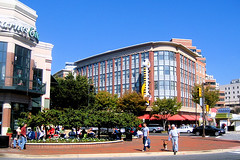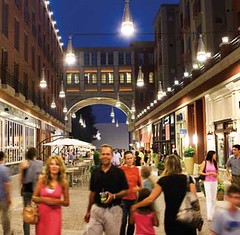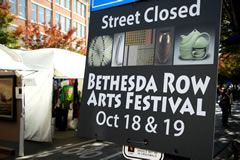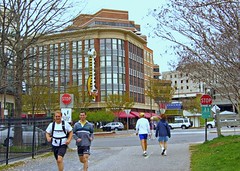The country's best suburban retrofit: Bethesda Row reaches maturity

Posted January 28, 2010 at 1:36PM
OK, maybe I haven't seen all the country's remade suburban neighborhoods, though I have seen or researched many. Naming one as "the best" is highly subjective anyhow. But Bethesda Row is definitely the best suburban retrofit I know, and I think you'd be hard pressed to find one better.
Great retrofit examples are important, because the remaking of outdated portions of suburbia into more coherent and sustainable places is a critical and growing frontier for smart growth. With motivation and skill, this can be done in a way that preserves the most important qualities that people seek in a suburban environment. As I have written in the past, this is exactly what was done in the case of Arlington, Virginia, where substantial commercial and residential development has been added in a major transit corridor without disturbing nearby single-family neighborhoods, which remain relatively serene, and without adding significant automobile traffic.
But none of the new development in Arlington, as good as it is, can match that of Bethesda Row, a private development (built with public planning and infrastructure assistance) that has been under way for over a decade in another of DC’s inner-ring suburbs, Bethesda, Maryland. For our 2001 book Solving Sprawl, my co-author Jutka Terris proposed the project’s inclusion, and had this to say about its serendipitous beginning:
“It all started in 1994, thanks to a strategically oriented balcony, where a group of employees of Federal Realty Investment Trust’s Bethesda office were taking a break. They had been searching for a model project to pioneer the real estate investment company’s new strategy of acquiring large multiblock sites and turning them into vibrant shopping and entertainment districts. “Why not here?” someone asked, pointing to an area visible from the balcony. The area had a strong potential customer base, and it already contained a public garage. It was also accessible by Metro, the regional subway system.”
By the time we published, Federal Realty had already taken eight acres along a badly faded automobile-oriented suburban strip and turned them into 388,000 square feet of immensely walkable and amenity-laden shops, offices, public spaces, restaurants, and more. In the years since, the company has added another 140,000 square feet of entertainment venues, more commercial and public space, a residential component, and the area’s best suburban pedestrian concourse. There’s a major supermarket, a farmers’ market every Sunday, and numerous lively festivals during the year. The neighborhood is always animated, but seldom feels crowded. The best part, in my view? Apart from the up-to-date names on many of the shops, Bethesda Row feels like it could have been there for decades.
In addition to its amazing public spaces (which also include a highly popular fountain area), one of Bethesda Row’s greatest assets is its transportation infrastructure. Yes, there’s the parking garage (and some nearby surface lots that will be developed), but in my opinion parking facilities are important for a suburb. And there is hardly any traffic congestion, in large part because the neighborhood is also steps away from a major rail transit station, multiple bus lines, and the offices, apartments and condos of Bethesda's downtown. A heavily used bike and pedestrian trail also runs right through the heart of the development. (See photo above.)
On the satellite image (taken in February 2008), Bethesda Row’s boundary is in yellow. The heart of Bethesda's suburban downtown is to the north. The red line denotes the below-ground Metro route, with the station circled; look closely for small blue squares marking the location of bus stops. The green line is the Capital Crescent bike and pedestrian trail, which originates in DC's Georgetown neighborhood, some seven miles to the south. One can also see several single-family neighborhoods within an easy walk from the development. But, wait, it’s only going to get better: Metro’s Purple Line light rail link between Bethesda and suburban Prince George’s County to the east will also soon have a stop nearby.
 I suppose it must be said that the success of Bethesda Row has been aided immensely by the affluence of its Montgomery County and northwest DC surroundings, and its location in a region that has not suffered nearly as much from the recession as elsewhere. It has had some advantages that many suburbs lack. I would like it even better if it had a good affordable housing component. But the project’s commercial and residential activity might easily have gone to other locations and contributed to sprawl had Bethesda’s leaders not welcomed the density and walkability of the project, and had Federal Realty’s commitment to excellence in vision, design and materials been less strong. This has been an outstanding project and a success from day one.
I suppose it must be said that the success of Bethesda Row has been aided immensely by the affluence of its Montgomery County and northwest DC surroundings, and its location in a region that has not suffered nearly as much from the recession as elsewhere. It has had some advantages that many suburbs lack. I would like it even better if it had a good affordable housing component. But the project’s commercial and residential activity might easily have gone to other locations and contributed to sprawl had Bethesda’s leaders not welcomed the density and walkability of the project, and had Federal Realty’s commitment to excellence in vision, design and materials been less strong. This has been an outstanding project and a success from day one.
Bethesda Row has won a number of awards, from such entities as the federal EPA, the Urban Land Institute, and the National Association of Home Builders. I could go on and on, but in this case I think the photos fill out the story much better than additional words would, so enjoy.







